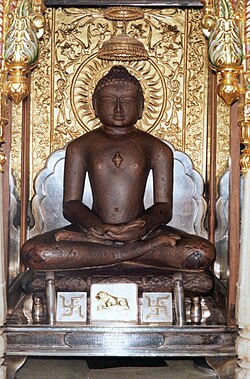
Back Digambara ALS Адзетыя ў неба BE-X-OLD দিগম্বর Bengali/Bangla Digambara German Digambaroj Esperanto Digambar Spanish دیگامبارا Persian Digambara Finnish Sectes Digambara French દિગંબર Gujarati


| Part of a series on |
| Jainism |
|---|
 |
Digambara (/dɪˈɡʌmbərə/; "sky-clad") is one of the two major schools of Jainism, the other being Śvetāmbara (white-clad). The Sanskrit word Digambara means "sky-clad", referring to their traditional monastic practice of neither possessing nor wearing any clothes.[1] Nakedness was the ideal practice of lord Mahavira and his immediate followers.[2] Mahavira emphasized the importance of nakedness for monks.[3] It symbolizes complete detachment and is an ideal form of conduct.[4] Mahavira believed that renouncing clothes made the body immune to external influences like heat and cold, increasing resilience. Without clothes, a monk would avoid the distractions of acquiring, maintaining, and washing garments, allowing him to focus on spiritual growth and self-discipline.[3]
Digambara and Śvetāmbara traditions have had historical differences ranging from their dress code, their temples and iconography, attitude towards female monastics, their legends, and the texts they consider as important. Digambaras maintain that women cannot attain nirvana. However, Śvetāmbaras differ and maintain that women as well as eunuchs can attain nirvana, having more inclusivity.[5][6][7]
Digambara monks believe in the virtue of non-attachment and non-possession of any material goods. Monks carry a community-owned picchi, which is a broom made of fallen peacock feathers for removing and thus saving the life of insects in their path or before they sit.[1]
The Digambara literature can be traced only to the first millennium, with its oldest surviving sacred text being the mid-second century Ṣaṭkhaṅḍāgama "Scripture in Six Parts" of Dharasena (the Moodabidri manuscripts).[8] One of the most important scholar-monks of the Digambara tradition was Kundakunda.
Digambara Jain communities are currently found mainly in most parts of India in states like Rajasthan, Uttar Pradesh, Delhi, Bihar, Jharkhand, Madhya Pradesh, Maharashtra, Karnataka and Tamilnadu.[7][9] According to Jeffery D. Long, a scholar of Hindu and Jain studies, less than one fifth of all Jains in India have a Digambara heritage.
- ^ a b Jeffery D Long (2013). Jainism: An Introduction. I.B.Tauris. pp. 17–18. ISBN 978-0-85771-392-6.
- ^ Barodia, U D (1909). History and Literature of Jainism. Jain Graduates' Association.
- ^ a b Balbir, Nalini (1982). "Review: SC Jain's 'Structure and Functions of Soul in Jainism'". Numen. 29 (1): 138. doi:10.2307/3269941. ISSN 0029-5973. JSTOR 3269941.
- ^ Dalsukh Malvania, C C Shah, Rishabhdas Ranka (1977). "Mahavira and his Teaching". Bhagwan Mahavir 2500th Nirvan Mahotsava Samiti.
{{cite web}}: CS1 maint: multiple names: authors list (link) - ^ Paul Dundas (2002). The Jains. Routledge. pp. 53–59, 64–80, 286–287 with footnotes 21 and 32. ISBN 978-0-415-26606-2.
- ^ Kristi L. Wiley (2009). The A to Z of Jainism. Scarecrow. pp. 83–84. ISBN 978-0-8108-6821-2.
- ^ a b Jyotindra Jain; Eberhard Fischer (1978). Jaina Iconography. BRILL Academic. pp. 1–2, 8–9, xxxiv–xxxv. ISBN 90-04-05259-3.
- ^ Paul Dundas (2002). The Jains. Routledge. pp. 63–65. ISBN 978-0-415-26605-5.
- ^ Jeffery D Long (2013). Jainism: An Introduction. I.B.Tauris. pp. 60–61. ISBN 978-0-85771-392-6.
© MMXXIII Rich X Search. We shall prevail. All rights reserved. Rich X Search